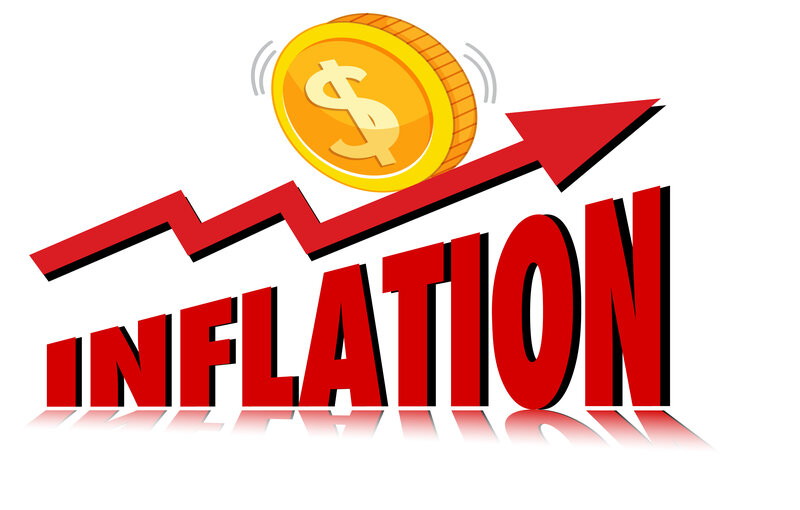How should Indian investors respond to US Inflation data?

As per recently released US Government data, the US Gross Domestic Product (GDP) contracted for second successive quarter in 2022. When the GDP declines for two consecutive quarters, it indicates that the economy may go into recession. However, the US equity markets continue to be strong for the last 2 months. The July consumer price index (CPI) data released last week showed that the CPI was flat in July after rising for the last 25 months. The inflation data sent US stock prices soaring with the Dow Jones (DJIA) gaining 1,200 points in the last 1 week (as on 15th August 2022). In India the Nifty 50 rose by nearly 600 points in the last 1 week.
Is the US going into recession?
Over the past 6 – 7 months we have been hearing of talks of high inflation and interest rate hikes dragging the US into recession. Russian invasion of Ukraine exacerbated those fears.Macro-economic data has a strong influence on equity markets. In all past recessions, US equities went into a bear market, but in the last 2 months the S&P 500 rallied by nearly 13% (as on 15th August 2022). US corporate profits in 2022 have been surprisingly strong and outlook is bullish. S&P 500 earnings per share (EPS) are expected to grow at 8.1% in 2022. Despite talks of recession, Wall Street seems to bullish about US economy.
Why is the US market bullish about the economy?
The US labour market continues to be strong despite GDP contraction; US employers added 528,000 jobs in the July (source: Reuters). This was significantly higher than what most economists were expecting. US employers continued to raise wages at a steady pace last month. Average hourly earnings increased 0.5% in July after gaining 0.4% in June (source: Reuters). Strong labour market is antithetical to recession fears. Employers will not be adding staff and increasing wages, if they expect their sales to drop in the near future. The strong US labour market data is supporting the equity markets.
Indications of inflation cooling in the US
Inflation data from the US looks encouraging. July CPI inflation was 8.5% on year or year basis, down from 9.1% in June. The June CPI inflation was the highest the US had seen in the last 40 years. CPI inflation after rising for 25 consecutive months till June remained flat in July, indicating that inflation may be turning a corner (source: Wall Street Journal). For us in India, the most encouraging sign from the US CPI data is the fall in gasoline (petrol is called gasoline in the US) prices. Gasoline or petrol prices fell by 7.7% in July from prior month. US inflation data and also data coming from China, indicating a sharp slowdown in Chinese economy may lead to further decline global crude oil prices (Brent crude prices have tumbled to $92.8 / bbl as on 15th August 2022, source: Bloomberg) in the coming months, which is very positive for India.
How has the Indian market reacted?
After the sell-off in April – June, the Nifty 50 bottomed around 15,300 levels and bounced back strongly. Nifty has rallied by nearly 2,500 points (16% growth) in the last 2 months (source: NSE, as on 16th August 2022). After months of relentless selling, Foreign Institutional Investors (FII) turned net buyers in the month of July. The recovery in the equity market has been broad-based with the Nifty 500 gaining 17% in the last 2 months (source: NSE, as on 16th August 2022); the broader market outperformed the Nifty slightly in the last 2 months. The equity market data shows that the market has bottomed out and is in the early stages of the next bull market. The data coming from the US supports this view.
How should Indian investors look at US data?
In this age of globalized financial markets, events in one part of the world do have impact on other parts. Indian market often takes cues from the US market. US economic data is quite encouraging for Indian investors. While there were recession fears earlier this year, many economists believe that the Fed will be able to accomplish a soft landing (no recession) for the US economy at the end of the interest rate tightening circle. If the Fed manages a soft landing for the US, it will be good news for our currency since the US dollar will weaken. We are also likely to see higher FII inflows in the coming months.
Historical precedence
The Fed had accomplished soft landing before as well. The 1990 - 91 US inflation rate crossed 5%. Though inflation moderated somewhat in the subsequent years, it was still above the Fed’s long term target of 2% in inflation. Between February 1994 and February 1995, the Fed hiked interest rates by 2.75%. The US economy did not fall into recession; in fact, what followed at the end of the interest rate cycle was a very strong period of US economic growth in the 90s, which continued in the 2000s. Many analysts expect the current interest rate cycle and economic impact will be similar to the mid 90s one.
Investors should be cautiously optimistic
Throughout this year, economists have been forecasting three scenarios for the US economy, a soft landing (no recession), a mild recession (lasting a few months) and severe recession (lasting more than a year). US jobs, corporate earnings and inflation data seem to be making a strong case for soft landing. Even if there is a mild recession in the US, the impact on Indian economy will not be significant. However, there may be some impact on the IT sector which is heavily reliant on exports if the US economy goes into a recession. IT stocks have seen sharp cuts in share prices this year and so some scenarios of reduction in tech budgets in US corporations are already discounted in share prices. However, we may see short term volatility depending on the data coming from the US. Investors should be disciplined and have long investment horizons. Asset allocation is very important for providing stability to your portfolio. You invest according to your asset allocation plan and consult with your financial advisor if you need help.
You may also like to read what should MF investors do in the high inflation high interest rate environment
India Growth Story is intact
- Our economy has bounced back from the slowdown caused by COVID-19 pandemic. As per last released Government data, the Index of Industrial Production (IIP) grew by 12.3% in June 2022. The IMF has forecasted India’s GDP will reach to $5 Trillion by FY 2026-27.
- Private Capex spending which has been sluggish for several years is on the cusp of revival and we are seeing early signs. Government infra spending, PLIs and Atmanirbhar Bharat scheme is likely to incentivize capex revival.
- Corporate profits are at decade high and growing strongly since the COVID-19 pandemic. This will further incentivize capex revival and economic growth.
- The growing middle income segment of our population (rising per capita income) and their aspirations is reshaping private consumption expenditure, which is strengthens the growth outlook of Indian equities.
What should equity investors do?
- You should be disciplined in your investing and always have long investment horizons. Minimum 5 years investment tenures are recommended for equity investors.
- You should continue to invest through SIP. SIPs will keep you disciplined and you can take advantage of market volatility through Rupee Cost Averaging.
- You should diversify across market cap segments. The early phase of a bull market is a good time to increase your allocations to midcap and small caps, since they tend to outperform large caps in bull market cycles. However, you should always invest according to your risk appetite.
What should fixed income investors do?
- Though the 10 year bond yield has eased a bit from its June high, it may revisit the June high depending on a variety of factors like Government borrowings, strength of the USD versus INR etc. Long duration debt funds may be volatile in the short term.
- Investors with short to medium investment tenures (less than 3 years) should invest in accrual based debt funds of different durations according to your risk appetite and investment tenures.
- Long term debt investors can lock-in high yields (5 to 10 year G-Sec yields around 7% +) by investing in rolled maturity debt funds. However, you need to have minimum 3 year investment tenures for these funds.
Conclusion
There are reasons to be optimistic about your investment outlook in the current market. The Indian economy is on the recovery path, valuations are not too expensive and long term outlook is bright. Investors should discuss their investment needs with their financial advisors and make informed investment decisions.
Mutual Fund Investments are subject to market risk, read all scheme related documents carefully.
RECOMMENDED READS
LATEST ARTICLES
- Importance of staying invested in the choppy market
- Two new promising smart beta funds: Nippon India Nifty 500 Low Volatility 50 and Nifty 500 Quality 50 Index Funds
- Going hybrid in the current environment
- Asset allocation is key to long term investing: Hybrid funds make a lot of sense in current market conditions
- Should you invest in momentum funds: Why momentum works in investing
The information being provided under this section 'Investor Education' is for the sole purpose of creating awareness about Mutual Funds and for their understanding, in general. The views being expressed only constitute opinions and therefore cannot be considered as guidelines, recommendations or as a professional guide for the readers. Before making any investments, the readers are advised to seek independent professional advice, verify the contents in order to arrive at an informed investment decision.
Mutual Fund investments are subject to market risks, read all scheme related documents carefully.
Quick Links
Follow Nippon India MF
More About Nippon India MF
POST A QUERY





